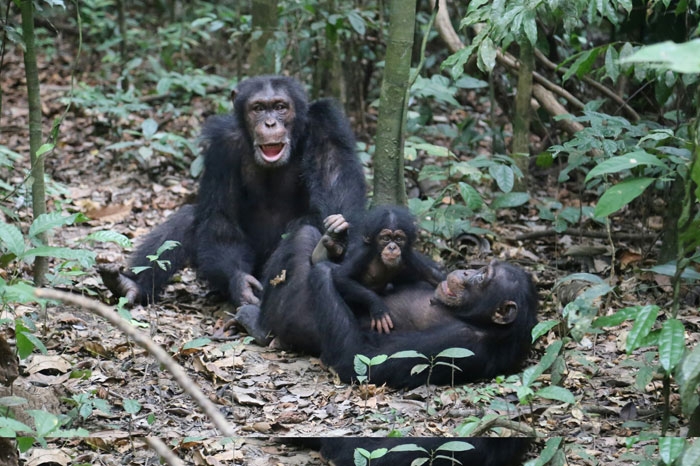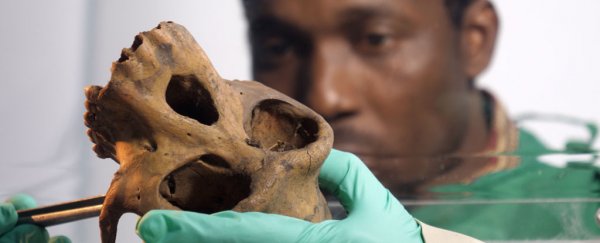A strange breed of anthrax bacterium killed more than half of the dead chimps analysed in new research from Africa – and scientists say the fatal infection could wipe out the local chimp population in the Ivory Coast.
As grave as the findings are, the greater implications of the Bacillus cereus biovar anthracis (Bcbva) bacterium could be that its infection vector isn't just limited to chimps – with researchers unexpectedly finding the strain had also killed animals from numerous other species.
"To our surprise, almost 40 percent of all animal deaths in Taï National Park we investigated were attributable to anthrax," says virologist Emmanuel Couacy-Hymann from the Ivorian Animal Health Institute.
Bcbva was first discovered back in 2004, when scientists found that dead chimps in the Taï National Park had been infected with an emergent strain of the usually harmless microbe, Bacillus cereus.
But this was no regular B. cereus, as the bug had somehow evolved to replicate the lethal molecular arsenal of Bacillus anthracis – the bacterium that causes anthrax.
 Liran Samuni/ Taï Chimpanzee Project
Liran Samuni/ Taï Chimpanzee Project
Specifically, Bcbva seems to have adopted B. anthracis's virulence plasmids – DNA strands that enable the bacterium to spread the Anthrax infection, which is carried when one animal eats an infected deceased animal.
Since the original discovery, researchers have found evidence that this dangerous hybrid has caused the deaths of chimpanzees, gorillas, and elephants in Cameroon and the Central African Republic, but the latest study paints an even grimmer picture.
In the new research, scientists analysed bone and tissue samples taken from the carcasses of more than 200 animals found in the region over the past 26 years.
When they examined the samples looking for traces of the anthrax pathogen, they found it was responsible for approximately 38 percent of local wildlife deaths – including several monkey species, duikers, mongoose, and a porcupine.
The worst toll was exacted on chimpanzees, though, with 31 of the 55 individuals examined having died from anthrax – and if things are left unchecked, the researchers fear the local population might not last another 150 years.
 Liran Samuni/ Taï Chimpanzee Project
Liran Samuni/ Taï Chimpanzee Project
"According to our projections, anthrax could over time contribute to drive chimpanzees in Taï National Park to extinction," says one of the team, Roman Wittig from the Max-Planck Institute for Evolutionary Anthropology in Germany.
The findings highlight that anthrax, which is usually found in arid conditions, can also threaten populations in tropical rainforest environments, but researchers still don't completely understand where the Bcbva strain comes from, nor how it spreads.
In the animal kingdom, anthrax usually threatens hoofed animals in dry plains, who become infected when they graze on bacterium-tainted soil. That's clearly not the case here, given chimps at least spend most of their time far off the ground.
"We don't know how they get infected," researcher Fabian Leendertz from the Robert Koch Institute in Germany, who helped originally discover Bcbva, told The Atlantic.
"How do the spores make it up in the trees?"
The most likely explanation is carrion flies, which might spread the pathogen from infected carcasses to food sources that chimps subsist on, like fruit.
It's only a hypothesis for now, but the study uncovered Bcbva DNA in 12 out of 103 flies examined in the research – which suggests flies could be playing a part here.
Fortunately, there are no reported cases of Bcbva-based deaths in humans – but that holdout may not last forever, and could be down to a lack of firm autopsy data rather than any kind of immunity to the pathogen.
"In these rural areas, no one really knows what people die of. In reports, it always says things like malaria or cholera, but these are not properly diagnosed," Leendertz told Ed Yong at The Atlantic.
"We have stories of people finding dead animals in the forest, eating them, and dying. But we can't link those to anthrax yet."
Until we know more, there's no cause for undue alarm here, nor are the researchers saying that this mysterious strain poses a risk to people.
But the data on Bcbva's spread among wildlife and chimps in particular – in climatic conditions not usually associated with anthrax – means there's a lot more we need to find out about here.
"This needs to be taken seriously," veterinary scientist Chris Whittier from Tufts University, who wasn't involved in the research, told Science.
"I hope this opens up a lot of people's eyes."
The findings are reported in Nature.
